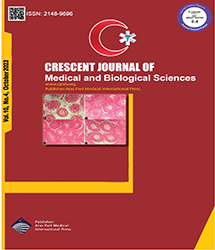
| Original Article | |
| Investigating the Level of Troponin I and its Association With Mortality in Patients With Sepsis, Severe Sepsis, and Septic Shock | |
| Mahboubeh Darban1, Ali Gohari1, Marjan Biglari1, Raheb Ghorbani2, Pourya Sheykhabbasi1 | |
| 1Department of Internal Medicine, School of Medicine, Semnan University of Medical Sciences, Semnan, Iran 2Social Determinants of Health Research Center, Semnan University of Medical Sciences, Semnan, Iran |
|
|
CJMB 2023; 10: 193-198 DOI: 10.34172/cjmb.2023.46 Viewed : 4191 times Downloaded : 4776 times. Keywords : Sepsis, Mortality, Troponin |
|
| Full Text(PDF) | Related Articles | |
| Abstract | |
Objectives: To investigate the level of troponin I and its association with mortality in patients with sepsis, severe sepsis, and septic shock. Materials and Methods: In general, 148 patients with sepsis, severe sepsis, and septic shock admitted to Kowsar hospital of Semnan in 2017-2019 were recruited in this study. Serum troponin levels were measured during the first 24 hours of admission. The second measurement was done in the next 48 hours, which aimed at increasing the likelihood of positive troponin over time. However, if the troponin was positive just once, the patient would be in the category of positive troponin. In addition, the patient's prognosis was recorded within 30 days. Results: Based on the results, 27.7% had troponin levels higher than normal. The mortality rate in patients with normal and abnormal levels of troponin was 5.6% and 17.1%, respectively, which was a significant difference. The age of dead patients was significantly higher than the age of the living patients and the results showed that among the variables of gender, normal or abnormal level of troponin, age, and type of underlying infection, only age had a significant relationship with patients" vital status. Conclusions: High levels of troponin were not effective in determining the prognosis of patients with sepsis, and only age had a significant relationship with patients' vital status while the confirmation or rejection of this hypothesis will need further studies. |
Cite By, Google Scholar
Google Scholar
PubMed
Online Submission System
 CJMB ENDNOTE ® Style
CJMB ENDNOTE ® Style
 Tutorials
Tutorials
 Publication Charge
Medical and Biological Research Center
About Journal
Publication Charge
Medical and Biological Research Center
About Journal
Aras Part Medical International Press Editor-in-Chief
Arash Khaki
Deputy Editor
Zafer Akan



















